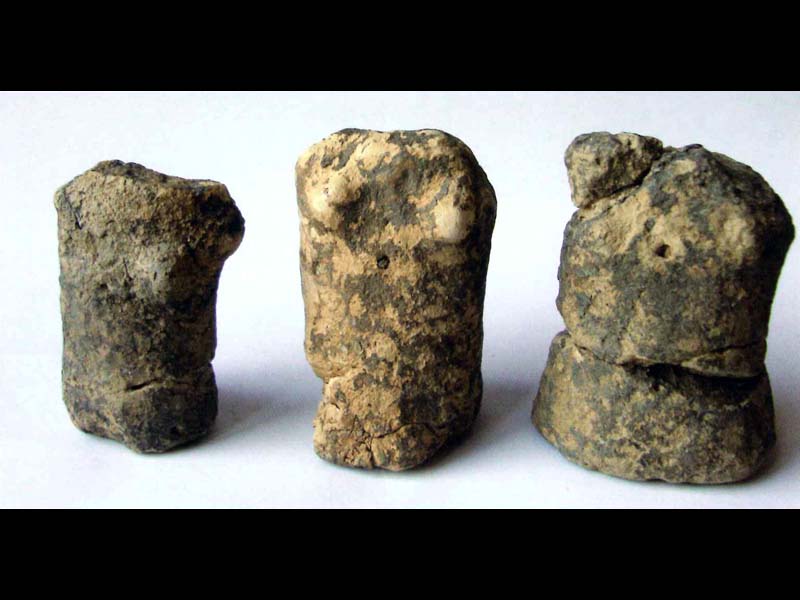These statuettes reproduce the schematized type of the naked female figure, according to the stylistic and iconographic canons of the early Neolithic art. They are made in the round, with a purified yellowish brown and undercooked dough: their state of conservation is not completely intact, in fact they have some gaps which, however, do not alter the understanding of the formal typology. The representation of the body is limited to the trunk, with a slightly concave profile: the fracture in the upper part deprives the statuettes of the neck, head and upper limbs, reduced to two small prominences; the lower limbs are replaced by a simple expansion of the base which also has the practical function of keeping the statuettes upright. The only recognizable anatomical detail is made up of the breasts, plastically rendered with two small conical protuberances applied to the upper part of the trunk.
The typology of the three statuettes appears to be widespread in the areas of the ancient eastern Italian Neolithic with different typologies, albeit all attributable to a simple and schematized iconography of the female figure. Female representations of the early Neolithic, mostly produced in terracotta, are particularly present in the Balkan regions and, in particular, it is in the Neolithic culture of Vinča that there is the greatest flowering of anthropomorphic representations, especially female: in some of these it is possible recognize the same stylization of the body typical of Ripabianca's statuettes, rendered with a simple cylinder with an expanded base and with barely sketched upper limbs. Very similar ones can also be found in the Neolithic village of Sammardenchia (Udine), as well as on the site of Catignano (Pescara): the diffusion of these statuettes in the regions of central-northern Italy therefore represents an important testimony of the cultural relations between these areas.
As far as iconology is concerned, these statuettes, often also referred to as "idolets", according to many authors symbolize both the idea of female fertility of Paleolithic origin, and that of Mother Earth's own fertility, connected with the new production needs of the first communities agricultural. The fact that the only recognizable attributes are the breasts, in a body that is decidedly schematic and unrealistic, probably had a precise symbolic value: as already for the Paleolithic "venus", the breast is one of the symbols par excellence of female to be a source of nourishment, and therefore, more generally, a giver of life.
It is interesting to note that the context of the discovery of this kind of statuettes is often connected to residential contexts, sometimes they are even found intentionally placed under the floors, as a foundation rite: it is therefore probable that a function was associated with them protective towards the home and the domestic productive context. They have often been found near the oven or in another place where the grain was prepared, to underline the intimate connection that must have existed, in the eyes of the agricultural community, between the grain, an important source of nourishment, and the female figure, symbol of the Goddess.


Historical notes
The site of Ripabianca di Monterado (Senigallia, Ancona), is located on the left bank of the Cesano river, 10 kilometers from the sea, about 2 kilometers north of the current town along the wide river valley which connects with the hinterland . It is an open site, excavated between 1962 and 1964, where an irregularly shaped basement structure was identified, made up of several cavities of various sizes, dug into the river sediment at different levels. In the walls there were niches: the south-west one, deeper, could be an oven, due to the filling soil rich in coal and the walls and vault cooked by fire. At the edge of the structure there were two inhumation burials, where the bodies were found lying down and in a supine position, without grave goods: one belonged to an elderly man, the other to an adult woman. A third burial was found to the east, unfortunately upset by the planting of a vineyard as was another found to the south, belonging to a child.
Inside the site, in addition to the statuettes, an abundance of lithic and bone instruments, obsidian (probably from Lipari), green stones (probably from the north-west), together with numerous ceramic forms of excellent workmanship and several jars were found. miniature. It is quite probable that this structure was not a simple hut: the complexity of the Ripabianca plant, of which there are similar examples throughout the ancient Italian Neolithic, together with the particularity of the finds found in it, can be traced back to a diversified use of this site, perhaps also associated with ritual practices.
CARD
LATEST PUBLISHED TEXTS
VISIT THE FACTSHEETS BY OBJECT

